The Gobi Desert, located in Central Asia, is one of the largest deserts in Asia, spanning across both Mongolia and China. It is renowned for its vast desert landscape, extreme temperatures, and unique ecosystem. With its sprawling sand dunes, diverse wildlife, and captivating geographical features, the Gobi Desert offers a truly unforgettable adventure.
Table of Contents
The climate in the Gobi Desert is characterized by extreme temperatures, with scorching hot summers reaching over 120 degrees Fahrenheit and bitterly cold winters with temperatures dropping below freezing. Despite these harsh conditions, the Gobi Desert is home to a remarkable variety of flora and fauna that have adapted to survive in this arid environment.
Exploring the Gobi Desert provides an opportunity to immerse yourself in the breathtaking beauty of its sand dunes, encounter elusive wildlife such as Bactrian camels and desert foxes, and marvel at its diverse geographical features, including plateaus, canyons, and rocky mountains.
Not only does the Gobi Desert offer a captivating natural experience, but it is also a place where visitors can immerse themselves in Mongolia’s rich nomadic culture. Interacting with the local nomadic herders, experiencing their traditional customs, and staying in traditional gers (yurts) will provide a deeper understanding of their way of life and the hospitality they offer.
If you’re seeking adventure, the Gobi Desert won’t disappoint. With trekking and hiking routes that traverse its various landscapes, camping under the starry skies, and the thrill of spotting unique wildlife, there are endless opportunities for exhilarating experiences in this extraordinary desert.
Key Takeaways:
- The Gobi Desert is one of the largest deserts in Asia, spanning Mongolia and China.
- It offers a unique ecosystem, featuring expansive sand dunes and diverse wildlife.
- Exploring the Gobi Desert provides opportunities to experience Mongolia’s nomadic culture and traditional customs.
- Adventure enthusiasts can enjoy activities like trekking, hiking, and camping in the desert.
- The Gobi Desert experiences extreme temperatures and an arid climate, making proper preparation essential.
Exploring the Gobi Desert’s Natural Beauty
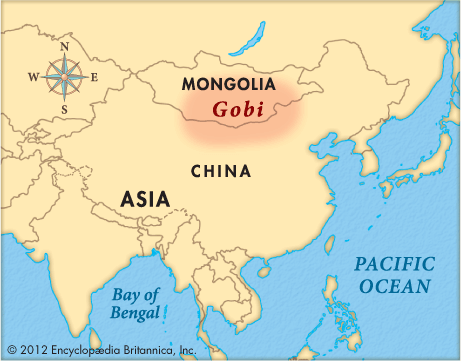
The Gobi Desert is renowned for its unique ecosystem that has thrived in the face of its harsh desert environment. This vast desert, which spans across Mongolia and China, is home to a variety of natural wonders and stunning landscapes.
Expansive Sand Dunes
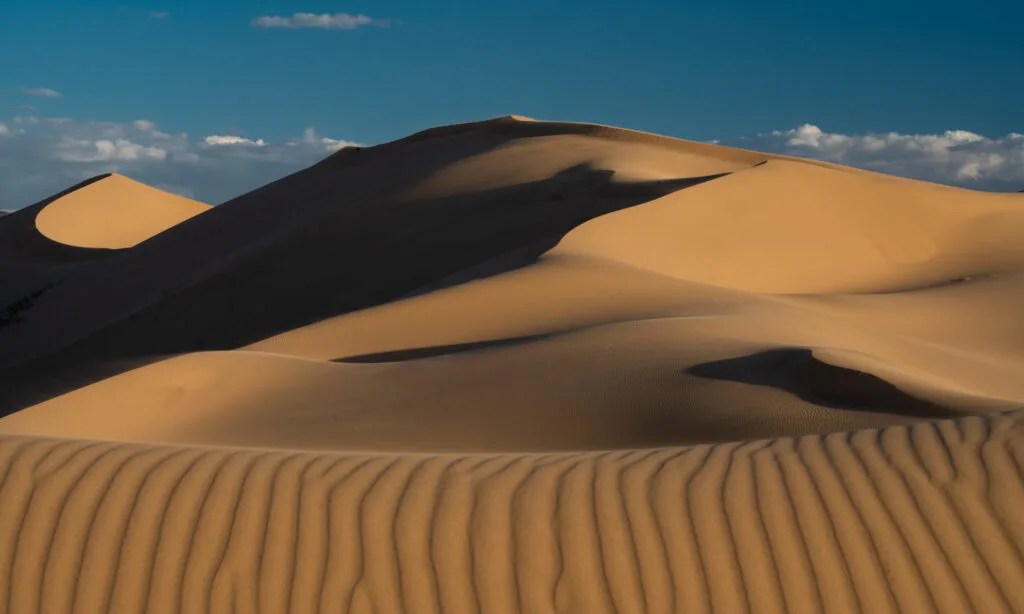
One of the highlights of the Gobi Desert is its expansive sand dunes, some of which are among the largest in the world. These towering dunes create a dramatic and breathtaking sight, showcasing the raw beauty of nature. The shifting sands and ever-changing patterns make them a photographer’s paradise and a must-visit attraction for nature enthusiasts.
“The Gobi Desert’s sand dunes offer a surreal and mesmerizing experience. They stretch as far as the eye can see, creating an enchanting landscape that is unlike anything I have ever witnessed before.” – Traveler testimonial
As you explore the Gobi Desert’s sand dunes, you’ll be amazed by their sheer size and the unique colors they exhibit, ranging from golden yellow to fiery red. They provide an ideal habitat for a variety of desert wildlife, including Bactrian camels, gazelles, and desert foxes.
Diverse Geographical Features
In addition to its mesmerizing sand dunes, the Gobi Desert is also home to a variety of geographical features that add to its natural beauty and allure. From vast plateaus to deep canyons and rocky mountains, the landscape of the Gobi Desert is as diverse as it is awe-inspiring.
Exploring the plateaus of the Gobi Desert allows you to enjoy stunning panoramic views, while venturing into the canyons reveals hidden oases and unexpected pockets of greenery amid the arid desert terrain. The rocky mountains that dot the landscape offer both a challenge and reward for adventurous hikers, with breathtaking vistas waiting to be discovered at their summits.
The Gobi Desert’s unique geographical features showcase the power and resilience of nature, making it a truly remarkable destination for those seeking to immerse themselves in the wonders of our planet.
Cultural Encounters in the Gobi Desert
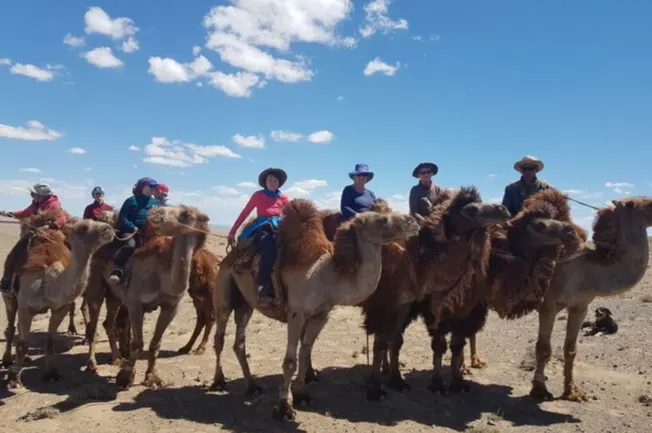
The Gobi Desert is not only a natural wonder but also a captivating destination for cultural exploration. As visitors venture into this vast landscape, they have the opportunity to immerse themselves in the rich nomadic culture of Mongolia.
The Gobi Desert is home to many nomadic herders who have preserved their traditional customs throughout the centuries. These nomads continue to live in traditional Gers, portable dwellings that have been used by nomadic communities for generations. The Gers provide a unique glimpse into their way of life, reflecting the harmonious relationship between people and nature in this demanding environment.
Interacting with the nomadic communities in the Gobi Desert offers travelers a chance to learn about their customs, traditions, and ancient practices. From traditional herding techniques to the art of making traditional clothing and handicrafts, visitors can gain a deeper understanding of the nomadic lifestyle.
“Nomadic hospitality is an essential part of our culture,” says Batbold, a local herder. “We welcome guests with open arms and treat them as family. Sharing meals, stories, and experiences is a way for us to connect and show our genuine hospitality.”
Exploring the Gobi Desert also unveils the historical significance it holds. It is the birthplace of Genghis Khan, the revered founder of the Mongol Empire. Travelers can delve into the rich history of the region and connect with this legendary figure who shaped the course of history.
While traversing the Gobi Desert, visitors can witness the heritage of Genghis Khan through various cultural landmarks and museums dedicated to his legacy. The enduring influence of Genghis Khan can still be felt in the nomadic customs and traditions practiced by the local communities.
The Warmth of Hospitality
The essence of the Gobi Desert experience lies in the warm hospitality of its people. Nomadic families welcome guests into their gers, offering them a glimpse into their daily lives and embracing them as part of their extended family. From enjoying traditional meals to engaging in heartfelt conversations around the crackling fire, visitors are immersed in a genuine sense of warmth and kinship.
This hospitality is deeply rooted in the nomadic culture, where the act of welcoming guests is considered a sacred duty. The nomads’ unwavering generosity and kindness provide a unique insight into human connection and the beauty of cultural exchange.
Trekking and Adventure in the Gobi Desert
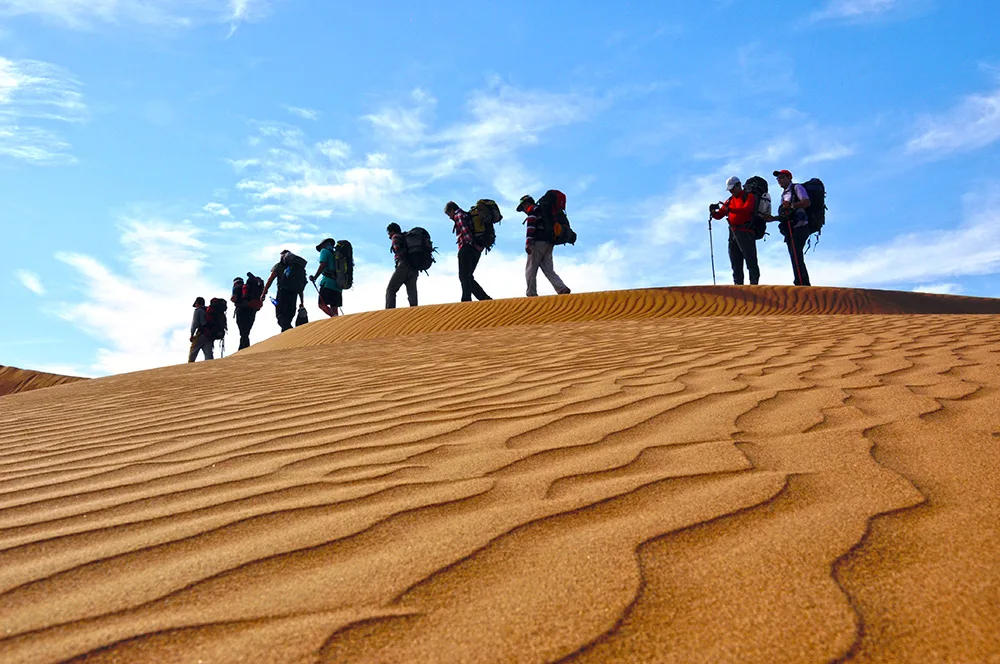
For adventure enthusiasts, the Gobi Desert offers a range of activities, including trekking and hiking. There are several trekking routes that allow visitors to explore the diverse landscapes of the desert, from vast open plains to towering sand dunes. Camping is a popular option for overnight stays, allowing travelers to immerse themselves in the desert environment and witness the breathtaking starry skies. Along the way, there are opportunities to spot unique desert wildlife and observe the ever-changing desert scenery.
Embark on an unforgettable adventure in the Gobi Desert, immersing yourself in its breathtaking landscapes and discovering its hidden wonders. With its vast open plains, towering sand dunes, and remarkable wildlife, the Gobi Desert offers endless opportunities for trekking and adventure. Whether you’re a seasoned hiker or a novice explorer, the Gobi’s diverse terrain and stunning vistas will leave you in awe.
“Trekking through the Gobi Desert is an extraordinary experience that allows you to connect with nature on a deeper level. The tranquility and vastness of the desert, combined with the sense of adventure, create a truly unique journey.” – Adventure Seeker Magazine
Exploring Diverse Landscapes
One of the highlights of trekking in the Gobi Desert is the opportunity to explore its diverse landscapes. From the expansive open plains to the towering sand dunes, each step reveals a new and awe-inspiring scene. Traverse the vastness of the desert, surrounded by stunning natural formations and breathtaking vistas. Whether trekking through rocky terrain or crossing vast sand dunes, every moment spent in the Gobi is an adventure in itself.
Encountering Unique Wildlife
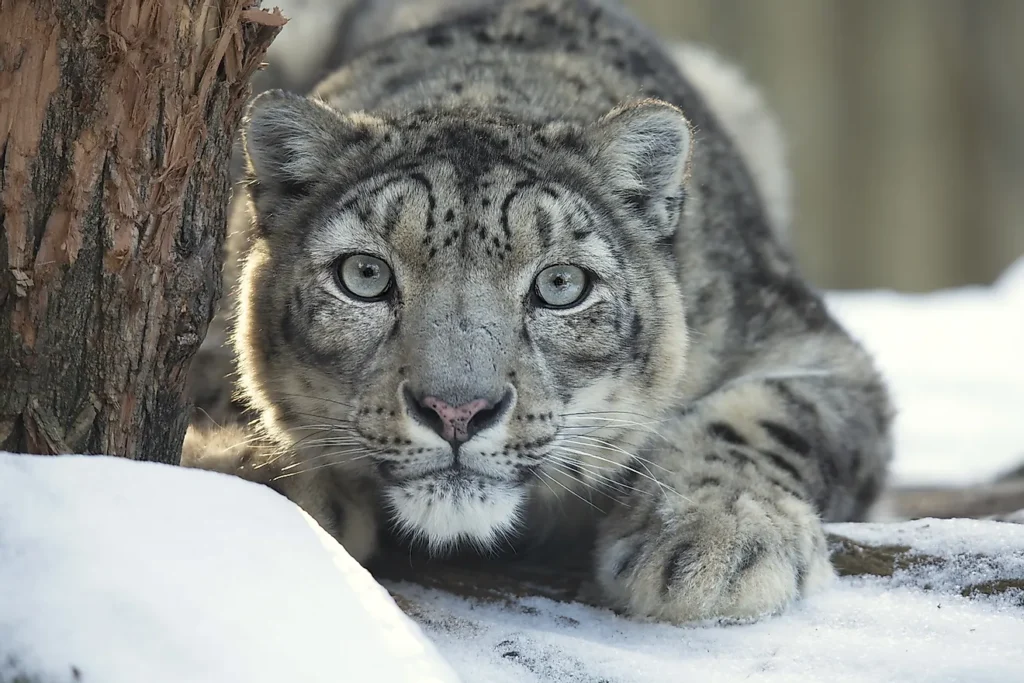
The Gobi Desert is home to a wide array of unique wildlife, making it a paradise for nature lovers. While trekking through the desert, keep an eye out for rare species such as the elusive snow leopard, the wild Bactrian camel, and the endangered Gobi bear. Witness the wonders of nature as you spot exotic birds soaring through the sky and observe desert foxes and gazelles navigating the arid landscape. The Gobi’s wildlife is a testament to the resilience and adaptation of life in this extreme environment.
Experiencing Desert Camping
There’s no better way to truly experience the magic of the Gobi Desert than by camping under its starry skies. Set up camp in the heart of the desert, surrounded by the serenity of the landscape. As the sun sets and the heavens reveal a blanket of stars, you’ll feel a sense of peace and wonder like never before. Fall asleep to the sounds of the desert and wake up to the golden hues of the sunrise, ready to embark on another day of adventure.
| Trekking Routes | Difficulty Level | Duration |
|---|---|---|
| Khongoriin Els Sand Dunes Trek | Moderate | 2-3 days |
| Yolyn Am Gorge Trek | Easy | 1 day |
| Bayanzag Flaming Cliffs Trek | Moderate | 2-3 days |
| Gurvan Saikhan Mountains Trek | Challenging | 5-7 days |
The Gobi Desert Climate and Weather
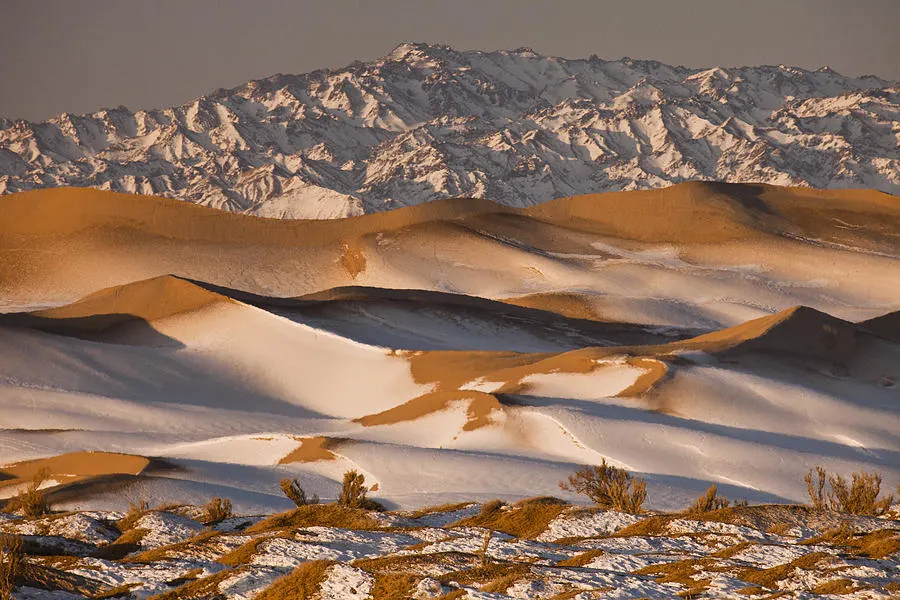
The Gobi Desert is known for its extreme climate and harsh weather conditions. With its arid and dry climate, the region experiences scorching hot summers and bitterly cold winters. During the summer months, temperatures in the Gobi Desert can soar above 120 degrees Fahrenheit, creating a challenging environment for both humans and wildlife. In contrast, winter temperatures can drop below freezing, with snowfall covering the vast desert landscape.
The Gobi Desert receives very little precipitation throughout the year, making it one of the driest places on Earth. The lack of rainfall contributes to the aridity of the region and further intensifies its extreme climate. Travelers planning a visit to the Gobi Desert should be prepared for these extreme weather conditions and take necessary precautions to ensure their safety and comfort.
Extreme Temperatures and Aridity
Extreme temperatures are a defining characteristic of the Gobi Desert climate. The scorching hot summers can be challenging, with high heat and intense sunlight. It is important for visitors to protect themselves from the sun by wearing sunscreen, hats, and lightweight, breathable clothing. Staying hydrated is also crucial, as the dry and arid conditions can cause rapid dehydration.
On the other hand, winter temperatures in the Gobi Desert can be bitterly cold, dropping below freezing point. Travelers should come prepared with warm layers, insulated clothing, and proper winter gear to stay comfortable in these frigid conditions.
The Impact of Aridity on the Ecosystem
The arid climate of the Gobi Desert has a significant impact on its unique ecosystem. The lack of rainfall limits vegetation growth, resulting in sparse plant life. However, some plant species have adapted to survive in the desert’s arid conditions, such as drought-tolerant shrubs and grasses.
The aridity also affects wildlife in the region. Many animals have developed adaptations to conserve water and withstand the extreme temperatures. The Gobi Desert is home to various desert-adapted species, including Bactrian camels, gazelles, and desert foxes, which have evolved to thrive in the challenging environment.
| Climate Quirk | Description |
|---|---|
| Extreme Temperature Swings | The Gobi Desert experiences significant temperature swings between day and night due to its arid climate. In some instances, the temperature can drop by more than 40 degrees Fahrenheit after sunset. |
| Frequent Sandstorms | The arid conditions in the Gobi Desert contribute to the formation of sandstorms. These violent windstorms can whip up vast amounts of sand and dust, reducing visibility and posing a challenge for travelers. |
| Low Humidity | The arid climate of the Gobi Desert results in low humidity levels, which can have an impact on human health and respiratory conditions. It is important for visitors to hydrate regularly and protect their skin from dryness. |
Exploring the Gobi Desert: Popular Destinations and Itineraries
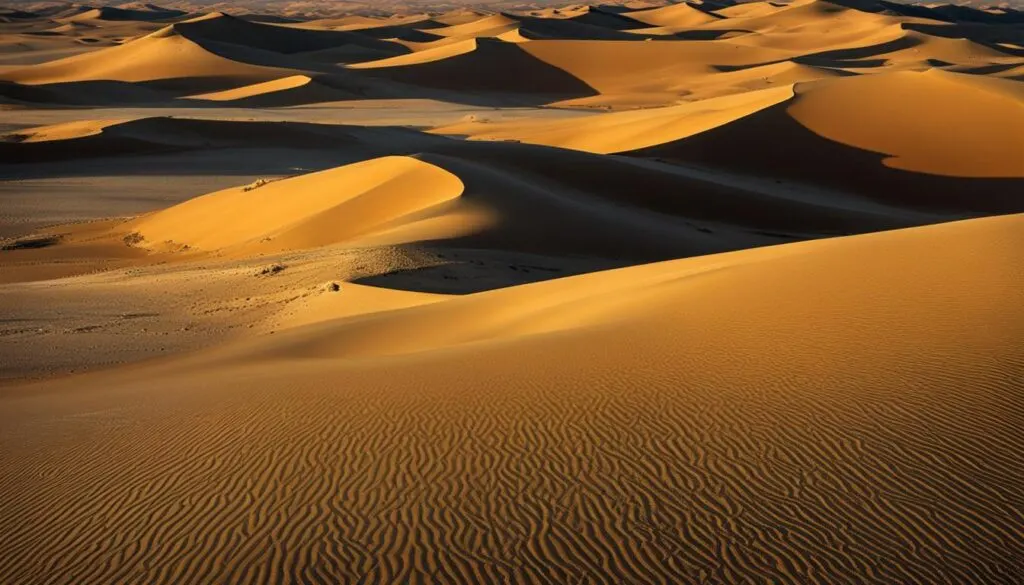
When exploring the Gobi Desert, there are several popular destinations and itineraries to consider. One of the must-see attractions is the Khongoriin Els Sand Dunes, also known as the Singing Dunes. These towering sand dunes offer stunning views and the opportunity to experience camel riding.
Another popular destination is the Yolyn Am, or Eagle Gorge, known for its dramatic rock formations and ice formations in the winter.
Other highlights include the Flaming Cliffs of Bayanzag, famous for its dinosaur fossils, and the ancient capital city of Karakorum, home to historical monuments and ruins.
Exploring the Gobi Desert is a journey filled with breathtaking sightseeing and unforgettable attractions. From the majestic sand dunes to the dramatic rock formations, there is something for everyone in this unique desert landscape.
With its diverse range of destinations and itineraries, the Gobi Desert offers an adventure like no other. Whether you’re exploring the Singing Dunes, marveling at the Eagle Gorge, or discovering the ancient ruins of Karakorum, the Gobi Desert is sure to leave you in awe.
Plan your trip to the Gobi Desert and embark on an incredible adventure filled with sightseeing and memorable attractions.
Practical Tips for Traveling to the Gobi Desert
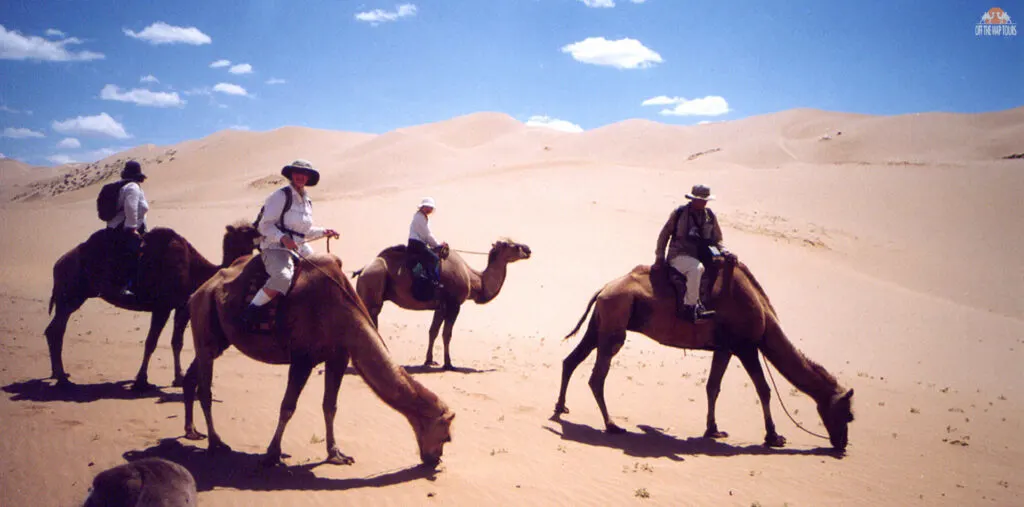
When planning a trip to the Gobi Desert, there are some practical tips to keep in mind.
First and foremost, it is important to pack appropriate clothing and gear for the extreme desert climate. The Gobi Desert experiences scorching hot summers and bitterly cold winters, so it’s essential to come prepared. Make sure to pack sunscreen to protect your skin from the intense sun, hats for shade, and lightweight, breathable clothing to stay comfortable in the heat. For winter visits, bring warm layers, gloves, and a hat to stay cozy in the chilly temperatures.
Another crucial tip is to bring plenty of water and stay hydrated. The desert environment can be incredibly dry, and it’s easy to become dehydrated without even realizing it. Carry a reusable water bottle and drink plenty of water throughout the day to avoid dehydration. Consider packing electrolyte tablets to replenish lost minerals during prolonged outdoor activities.
The best time to visit the Gobi Desert is during the spring and fall when temperatures are more moderate. The weather during these seasons is milder, making it more comfortable for exploring the desert landscapes and engaging in outdoor activities. It’s important to check the weather forecast before your trip and be prepared for any unexpected changes in weather conditions.
Lastly, it is recommended to book accommodations and transportation in advance, as the Gobi Desert can be quite remote, and infrastructure may be limited. Plan your itinerary and make arrangements for accommodations, transportation, and any guided tours or activities you wish to experience. This will ensure a smoother and more enjoyable trip to the Gobi Desert, allowing you to fully immerse yourself in the unique beauty and culture of this remarkable destination.
FAQ
Q: What is the Gobi Desert?
A: The Gobi Desert is one of the largest deserts in Asia, spanning across both Mongolia and China. It is known for its vast desert landscape and extreme temperatures.
Q: What is unique about the Gobi Desert?
A: The Gobi Desert boasts a unique ecosystem with sand dunes, diverse geographical features, and wildlife, including Bactrian camels, gazelles, and desert foxes.
Q: Can I experience the local culture in the Gobi Desert?
A: Yes, the Gobi Desert is home to nomadic herders who maintain traditional customs. Visitors have the opportunity to interact with these nomadic communities and learn about their way of life.
Q: What adventure activities can I engage in while in the Gobi Desert?
A: The Gobi Desert offers trekking, hiking, and camping opportunities. Travelers can explore diverse landscapes, observe wildlife, and enjoy the breathtaking starry skies.
Q: What is the climate of the Gobi Desert?
A: The Gobi Desert has an arid climate with extreme temperatures. Summers can reach over 120 degrees Fahrenheit, while winters can drop below freezing. The region receives very little precipitation.
Q: What are the popular destinations and itineraries in the Gobi Desert?
A: Popular destinations include the Khongoriin Els Sand Dunes, Yolyn Am (Eagle Gorge), Flaming Cliffs of Bayanzag, and the ancient capital city of Karakorum.
Q: What practical tips should I keep in mind when traveling to the Gobi Desert?
A: It is important to pack appropriate clothing and gear for the extreme desert climate, bring plenty of water, and book accommodations and transportation in advance, as the Gobi Desert can be remote.
Read more
The Mojave Desert: An Oasis of Natural Wonders and Desert Life
Marvels of the Atacama Desert: From Salt Flats to Starry Nights

